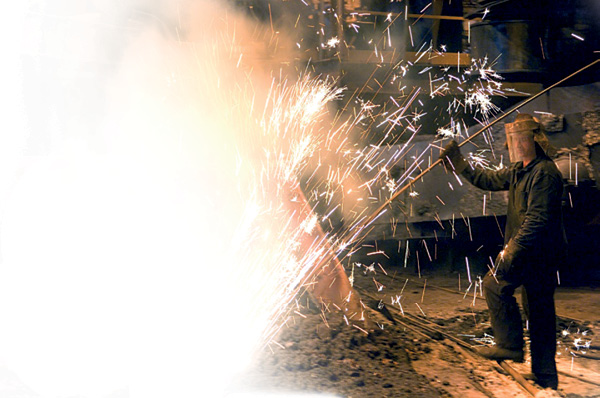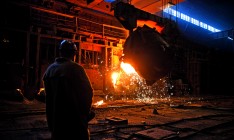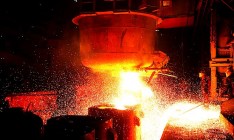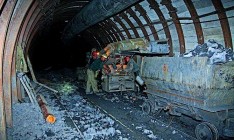Business
metallurgyUkrainian metallurgists are going through hard times at home and abroad

This past year for Ukrainian steel mills was marked by a significant decline in practically all performance indicators. For steelworkers only export dependence increased, as they shipped out of the country 88% of all steel produced, whereas in the past year this figure was 81%.
Steel on the reel
The military operation in the Donbas resulted in a reduction of steel production in the country by 5.5 mn t compared to 2013, which is equivalent to a yearly downtime of a major steelmaker. Actually, since the summer one of the steel mills has been idle (Alchevsk Iron and Steel Works), two of the plants in Mariupol (Illich Iron and Steel Works and Azovstal) and one plant in Yenakiyevo have been operating at a reduced capacity (50–70%).
At the same time, there are companies which did not cut production compared to the previous year (ArcelorMittal Kryviy Rih), and, on the contrary, Zaporizhstal managed to increase output. “At year end steel production in the country will amount to just over 27 mn t,” predicts Analyst at the Ukrpromzovnishexpertyza SE Pavlo Perkonos, noting that if the situation in the industry does not deteriorate, next year the companies will be able to maintain these volumes if the plan of Alchevsk is launched.
Naturally, reduction in output of steel products affected its sales on both domestic and foreign markets. “In absolute terms, exports of steel products in 2014 will fall by 2.4 mn t, while deliveries to the domestic market will decrease by 2.5 mn t,” Perkonos calculated. Foreign currency earnings from exports of metal this year will decrease by 13.6% to US $16,050 bn and will persist at the same rate next year: 14.1% (down to US $13.794 bn). The physical volume of exports of steel products, according to industry analysts, will remain at this year’s level or decline by 1 mn t by 2014.
In addition to falling export volumes, reduction of revenues was due to the fall in the prices of steel products on key markets and will continue. Moreover, the rate of decline in metal prices in Black Sea ports next year will accelerate from 2–7% (in 2014 to 5–11% in 2015.
Suppliers managed to maintain export positions and even slightly strengthen them in only two regions of the country. “Over nine months of 2014 exports to the EU-27 increased by 3.5% to 6.38 mn t compared to the same period in 2013 and to African countries – by 13.6% to 3.797 mn t,” says Perkonos.
At the same time, the supplies of Ukrainian metal to the U.S. have increased significantly. In January–September exports of domestic steelmakers increased 1.6 times to 541,000 t. In addition to that, metallurgists were forced to move over on Asian markets with a decrease in export of 34.4% to 1.275 mn t, the CIS (30.5% to 3.031 mn t), Central and Eastern Europe (12.2% to 3.031 mn t) and the Middle East (10.4% to 3.152 mn t).
Chinese competitors took Ukrainians’ place on markets in Asian countries and the Middle East. The decrease in supply in the CIS was due to the “collapse” of the Russian market. This year, domestic steel exports to the Russian market fell 1.2 times to 1.3 mn t, while in 2012–2013 its volume reached 3.3–3.4 mn t.
Prime cost
Fortunately for metallurgists, despite the decrease in revenues, their costs also fell. They were able to reduce the cost of production of their products thanks to the decrease of the price of iron ore. Since the beginning of 2014, its price dropped by almost twofold from US $130 to US $70 per ton. “The share of iron ore raw materials accounts for almost a third of the prime cost of steelmaking,” says Analyst at the Eavex Capital Investment Company Ivan Dzvinka. “As such, the decline in benchmark ore prices by 50% means a 15–17% reduction of the cost of steel production. Due to this, competitiveness of Ukrainian steelmakers increased in comparison with their Turkish colleagues. In Turkey, 70% of steel production capacities use scrap metal, which lost in terms of price not as much as iron ore.
Devaluation of the national currency against the U.S. dollar helped Ukrainian steelmakers compete on world markets. “The devaluation of the hryvnia had a positive effect for metallurgists, especially for vertically integrated companies,” said Dzvinka, giving the example of the Metinvest Group, for which the devaluation effect over 9 months in 2014 amounted to US $1 bn (that’s half of EBITDA and 12% of revenues). Although CEO of Metinvest Holding Yuriy Ryzhenkov assures that in terms of a 100% load the group’s enterprises can compete on the world market regardless of the devaluation of the hryvnia and the positive effect of devaluation is not that significant, he claims.
In 2015, the devaluation and the expected decline in ore prices will reduce the cost of production of steel by approximately US $30–37 per ton and China may follow the example of Russia and Ukraine. “China is going to devalue its national currency, which will reduce the cost of steel even further and, therefore, push export prices down even lower,” complains analyst at the Concorde Capital Investment Company Roman Topolyuk.
This year falling iron prices contributed to strengthening of positions of Chinese steelmakers, the main competitors of Ukrainian steel melters on export markets. “Due to lower prices of iron ore and dumping over ten months of 2014 China increased its steel exports by 47% (84 mn t) compared to January–October 2013, while expanding its presence on markets crucial for Ukraine, Europe and the Middle East,” said Dzvinka. This year, China will increase exports to the EU-27 by 85% (to 6.3 mn t), and to the rest of Europe – by 35% (up to 908,000 t), to the Middle East – by 48% (up to 8.3 mn t).
Analysts at Ukrpromzovnishekspertyza estimated that in 2014 the cost of Ukrainian steel billets manufactured by vertically integrated companies decreased by US $61 per ton to US $422. However, the production cost of Chinese billets dropped even lower – by US $83/t, to US $415/t. However, the Russians are ahead of everyone: the rate of decline of the cost of their metallurgical products was significantly lower (by US $40 per t), but the prime cost cannot be compared to any Ukrainian or Chinese products (this year it was US $384 per t).
Markets
So, in future the competition on world steel markets will only become stiffer. Due to this, the geography of exports of Ukrainian steel stands a good chance of being changed.
On the one hand, experts expect an improvement of China’s performance on markets in the Middle East and Africa, which would pose a threat to Ukrainian steel. In addition, as a result of declining oil prices the market in the Middle East will shrink, their solvency will plummet and, accordingly, implementation of many projects that require steel will be slowed down or delayed. As to the EU-27 markets, Perkonos believes that the margin of increase in supplies of Ukrainian metal in that direction has been exhausted.
Exports of domestic steel products to Russia will definitely decrease and in 2015 the decline may reach 10–15% in comparison with 2014. Despite this, the decline was predictable. Russia has been actively introducing new steel capacities and implemented the policy of substitution of imported metal. In the future, new capacities will increase the loads and trade relations between the two countries will deteriorate, which, of course, will entail a reduction in exports. “We should not rule out the possibility of imposing of trade sanctions against Ukrainian metal, because to Russian consumers our metal products have always been interesting in terms of price,” says Topolyuk, noting that the current devaluation of the ruble has already made deliveries of Ukrainian steel to the market unstimulating.
On the other hand, Ukrainian steelmakers have a chance to increase the supply of metal to the U.S., which could slightly compensate the further narrowing of the Russian market.
“Over the past six months the U.S. passed several decisions that are positive for Ukrainian steel producers,” says Topolyuk. In particular, duties on imports of seamless pipes and rods were abolished until 2017 (previously their rate was 116%). Also, in November 2014 the term of protectionist duties on hot-rolled sheets, which has been in effect since the beginning of the century and reached 238%, expired. “Given the warming of relations between Ukraine and the U.S., I believe the sanctions on sheet metal will not be renewed,” says Topolyuk.
Semi-finished products
Be that as it may, semi-finished steel products will be the main driving force that can maintain the volume of Ukrainian metal exports at least at the level of this year. “The share of semi-finished products in the sales pattern is likely to increase from 45% in 2014 to 50–55% in 2015,” predicts Dzvinka. The high cost of scrap metal is forcing major consumers of Ukrainian semis – Turkish metallurgists – to stop their electric-furnace steelmaking capacities for loading rolling capacities.
Back in August–September EBITDA profitability of sales of Ukrainian semis exceeded US $100/t, which was related to devaluation of the Ukrainian currency. At the moment, the situation has stabilized and profitability of sales of billets has dropped sharply, though selling semi-finished products now is still cheaper than selling finished products. “The current price of US $400–410 per ton of billets (as of the end of December, FOB, Black Sea ports) allows metallurgists working without the use of pulverized coal technology to sell them abroad with margins of around US $20–25 per ton,” calculated Perkonos. Analysts say that the current difference in the prices of billets and finished products is lower than the cost of rolling of billets into finished products, which means that selling semi-finished products is more cost-effective.





 of the agreement of syndication with Financial Times Limited are strictly prohibited. Use of materials which refers to France-Presse, Reuters, Interfax-Ukraine, Ukrainian News, UNIAN agencies is strictly prohibited. Materials marked
of the agreement of syndication with Financial Times Limited are strictly prohibited. Use of materials which refers to France-Presse, Reuters, Interfax-Ukraine, Ukrainian News, UNIAN agencies is strictly prohibited. Materials marked  are published as advertisements.
are published as advertisements.